Hebrew Persecution
In 130 A.D. The Roman Emperor Hadrian planned a great temple to Zeus in the newly founded city of Aelia Capitolina, which was on the ruined site of Jerusalem. Moreover, Hadrian had recently outlawed circumcision. these Romanizing acts of the government, easily ignited the second great revolt of the Hebrews against Rome. This was the Bar Cochba or Kochba, (nickname for Simon - (Son of the Star), Revolt of 132 to 135 A.D, which was led by Simon ben Kosiba, (Simon son of Kosiba). Once again the Romans raised an enormous army to put down the revolt. Hadrian personally led the Roman attack on the rebels.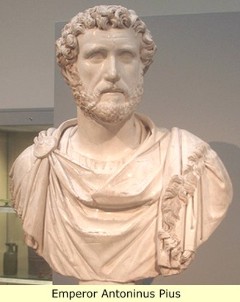
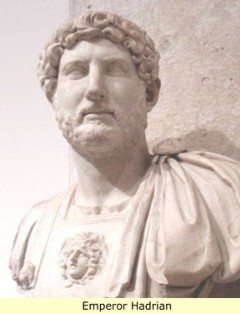
In the aftermath of the Bar Cochba Revolt, the Romans excluded Hebrews from a large area around Aelia Capitolina, which Romans only inhabited. The province now hosted two legions and many auxiliary units, two colonies, and a new name, "Syria Palaestina" to replace Judaea. The center of Hebrew settlement moved northward to Galilee and Gaulanitis. The number of Hebrew communities elsewhere declined, and many once Hebrew towns became Roman or received large numbers of Roman inhabitants. The towns lost their old Hebrew names for new Roman names. The ban on circumcision remained in effect until Antoninus Pius, who recognizing its dangerously provocative effect, revoked it.
After 135 A.D. Hebrews no longer had political, urban, or territorial institutions that could support another revolt, but they managed to maintain national identity as a result of the growth of rabbinical institutions and the patriarchate in Galilee. Poverty, famine, plague, and crime left the Hebrews too weak to mount any organized resistance.
The new state of Syria Palaestina thus became a good deal less problematic for the Roman government than Judaea had been. The government continued to permit the Hebrews certain religious freedoms, such as exemption from the imperial cult, and gradually the Roman governors permitted the Hebrews to recover certain of their communal rights, such as local courts and internal government, under the overall authority of the patriarch in Tiberias. The Samaritans (a sect practicing a strict and uncompromising version of the Hebrew religion), fared less well, as the Romans took steps to prevent a resurgence of Samaritan nationalism by founding a pagan temple on Mt Gerizim, just south of Neapolis, and refused to make concessions to Samaritan religious practices.
The conversion of Emperor Constantine to Christianity in about 300 A.D. set in motion events that made Palestine a major center of the Christian church. Before the fifth century A.D. very few Christians lived in Palestine. The non-Hebrew regions of the coast, the south, and Aelia Capitolina had several Roman and Greek Christian communities, and a few Minim (Hebrew Christians) lived in such Galilean towns as Sepphoris and Capernaum.
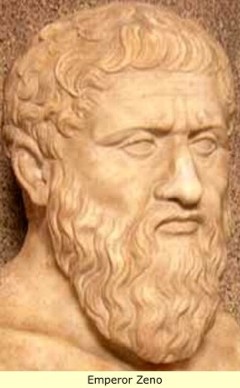

But beginning in the fourth century the government responded to Roman Christian interest in the Holy Land; by embarking on a massive program of patronage, especially church-building, that was designed to encourage Christians to move to Palestine. There was also an imperial policy geared to encourage Hebrews to convert to Christianity; this by offering protection and rewards.
As a result of Christian settlement in the vicinities of Nazareth, Capernaum, and Tabgha, the region of Galilee lost its Hebrew majority. By about 400 A.D. there were ninety six Christian communities in Palestine. The sack of Rome in 410 A.D. caused a new round of migration to Palestine as a group of aristocratic Romans responded to Jerome's invitation to settle in Aelia Capitolina and Bethlehem, (Jerome was a Caucasian born in Stridon (a city in modern Croatia), he was probably of Turkish/Khazar ethnicity, he was later canonized a Saint by the catholic Church. In addition, numerous Christians came to Palestine not to settle but to visit holy sites on pilgrimage and to scour the land for relics to take home.
On the other hand, the Hebrew population saw a constant and precipitous drop that lasted for centuries. In the second century, after the Bar Cochba Revolt, some two hundred Hebrew communities flourished in Palestine, but by the time of the Arab conquest in the late 630s we know of fewer than fifty. Except in the towns of Tiberias and Sepphoris and in the regions east of the Sea of Galilee, the Hebrews had become a minority in their own country.
 The Christian and Hebrew leadership had encouraged their followers to have nothing to do with each other. Most Christian-Hebrew exchange took the form of vigorous attacks on the opinions and principles of each other. Now, after the conversion of Constantine, Christians found themselves in a position not merely to keep themselves separate from contamination by Judaism but to actively suppress it.
The Christian and Hebrew leadership had encouraged their followers to have nothing to do with each other. Most Christian-Hebrew exchange took the form of vigorous attacks on the opinions and principles of each other. Now, after the conversion of Constantine, Christians found themselves in a position not merely to keep themselves separate from contamination by Judaism but to actively suppress it.The Roman Emperors codified the separation of the two religions by forbidding intermarriage and conversion from Christianity to Judaism. However, Hebrew converts to Christianity; received protection from Hebrew retribution. Increasingly the Hebrews lost civil status. Imperial legislation labeled Judaism a wild and nefarious sect. Until about 500 A.D. Roman emperors regularly reaffirmed the Hebrews right to the free exercise of their religion, but it became increasingly difficult to control violence against the Hebrews and their property.
The accession of Roman Emperor Justinian, in 527 A.D. initiated the last great phase of Roman persecution of the Hebrews. The new emperor redefined heretics to include the Hebrews and excluded them from military and civilian offices. They had never served in the army, but now they could not even serve even in local municipal government. The leadership of the last Hebrew cities, Tiberias and Sepphoris, passed into Greek and Roman hands. Justinian dealt a further blow to the Hebrews when the new compilation of Roman law, the Codex Iustinianus, omitted the ancient law declaring Judaism a legitimate religion, and began to attack Hebrew religious practices and to force baptism.
 |
Click Here for the History of Early Christianity. <<CLICK>> |
Click Here for the histories and images of some of the first Christians: <<CLICK>>> |
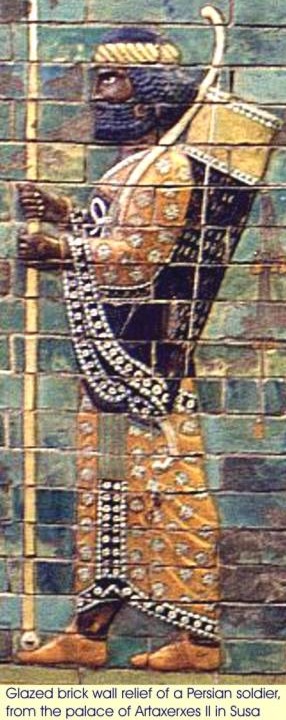 Meanwhile there appeared renewed resistance from the Samaritans (a sect practicing a strict and uncompromising version of the Hebrew religion), they had never received any of the privileges that the Romans afforded the more liberal Hebrews. They were forbidden to circumcise their children since the second century, and forced to sacrifice to the pagan gods during the Tetrarchy. Now they were suffering under the Christian empire, even greater oppression than the Hebrews.
Meanwhile there appeared renewed resistance from the Samaritans (a sect practicing a strict and uncompromising version of the Hebrew religion), they had never received any of the privileges that the Romans afforded the more liberal Hebrews. They were forbidden to circumcise their children since the second century, and forced to sacrifice to the pagan gods during the Tetrarchy. Now they were suffering under the Christian empire, even greater oppression than the Hebrews.The Samaritans revolted against Emperor Zeno in 484 A.D. The Roman government put them down ruthlessly, and built a Christian church on their holy mountain, (Mt Gerizim) near Neapolis. Again in 529 A.D, they revolted after Justinian ordered the destruction of their synagogues. After they restored control, the Romans deported or forcibly baptized Samaritans and installed a garrison there. In both great revolts the Samaritans briefly set up their own royal state in the Davidic style.
In 603 A.D. the last war between Rome and Persia began. The Persians gradually occupied the eastern parts of the empire and in 613 A.D. they took Damascus. Then later, with Hebrew assistance, they occupied all of Palestine. They took Aelia Capitolina in 614 A.D. and gave it to the Hebrews. But within a few years they restored it to the Christians, because it was easier to deal with the majority population, which was Christian. In 622 A.D. Roman Emperor Heraclius turned the tide against Persia, and in 629 A.D. he recovered Palestine.
The Arab/Eurasian Invasion
But within a few years the Muslims - a conglomeration of Turks, Greeks, and Arabs, under the banner of the Prophet Muhammad - attacking from the south, through a Hebrew population that had no love for the Roman Empire, easily conquered Palestine.The invasion began in 634 A.D, Gaza fell first, and the attack continued northward until, after the Battle of the Yarmuk southeast of the Sea of Galilee in 636 A.D. the Roman army withdrew from Palestine and Syria. Jerusalem held out until the spring of 638 A.D. Caesarea fell last, in 641 A.D, and with its conquest, the Muslims ended seven hundred years of Roman rule in Palestine.
From the time of the Roman occupation, Canaanites and Hebrews and begun to leave Canaan. By the time of the Muslim invasion, with the majority of the population already killed or displaced by Romans and Greeks, there is no telling how many were left alive to flee.
One group whose flight can be traced, is that of the Lemba tribe in Zimbabwe. They have maintained their Hebrew religion and traditions through the many centuries. { They were genetically tested, and confirmed to be Hebrews}. Hebrews also fled to Ethiopia and other countries.
Note: Nowhere in this history, have we shown how the Hebrews turned into White people. For an answer to that question, Click Here. Click >>> |
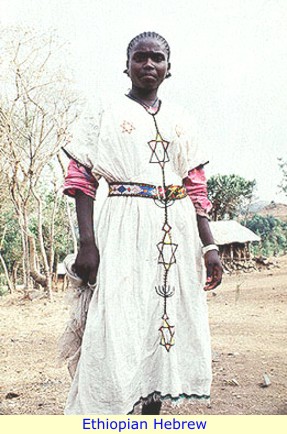

Those Hebrews who could not, or would not flee were Doomed. The Muslim Holy Books tell of their fate.
| Qur'an 059.014 YUSUFALI: They (Hebrews) will not fight you (even) together, except in fortified townships, or from behind walls. Strong is their fighting (spirit) amongst themselves: thou wouldst think they were united, but their hearts are divided: that is because they are a people devoid of wisdom. PICKTHAL: They will not fight against you in a body save in fortified villages or from behind walls. Their adversity among themselves is very great. Ye think of them as a whole whereas their hearts are divers. That is because they are a folk who have no sense. SHAKIR: They will not fight against you in a body save in fortified towns or from behind walls; their fighting between them is severe, you may think them as one body, and their hearts are disunited; that is because they are a people who have no sense. |
| Qur'an 033.026 YUSUFALI: And those of the People of the Book (Hebrews) who aided them - Allah did take them down from their strongholds and cast terror into their hearts. (So that) some ye slew, and some ye made prisoners. PICKTHAL: And He brought those of the People of the Scripture who supported them down from their strongholds, and cast panic into their hearts. Some ye slew, and ye made captive some. SHAKIR: And He drove down those of the followers of the Book who backed them from their fortresses and He cast awe into their hearts; some you killed and you took captive another part. |
| Qur'an 033.027 YUSUFALI: And He made you heirs of their lands, their houses, and their goods, and of a land which ye had not frequented (before). And Allah has power over all things. PICKTHAL: And He caused you to inherit their land and their houses and their wealth, and land ye have not trodden. Allah is ever Able to do all things. SHAKIR: And He made you heirs to their land and their dwellings and their property, and (to) a land which you have not yet trodden, and Allah has power over all things. |
| Tabari VIII:121 Ali struck the Hebrew with a swift blow that split his helmet, neck protector, and head, landing in his rear teeth. And the Muslims entered the city. Muhammad conquered the [Hebrew] neighborhood. Safiyah was brought to him, and another woman with her. Bilal led them past some of the Hebrews we had slain including the woman's dead husband. When she saw them, the woman with Safiyah cried out, slapped her face, and poured dust on her head. When Allah's Prophet saw her, he said, Take this she-devil away from me! |
Safiyah Safiyah Bint Huyeiy Ibn Akhtab, was a Hebrew woman who was captured when Muhammads troops attacked Khaibar. Safiyah was seventeen and very beautiful when Muslims killed her father, husband and many of her relatives. She was brought to the Prophet as his share of the booty. The Prophet desired her, but Safiyah requested the Prophet to wait till he had gone a stage away from Khaibar. One mile from Khaibar, the Prophet married Safiyah. |
Bilal Bilal ibn Rabah was an Ethiopian slave born in Mecca in the late 6th century. Slavery was common in Mecca, and many slaves accepted Islam. When an ordinary free man accepted Islam, despite opposition, he would enjoy the protection of his tribe. For slaves however, there was no such protection, and they were subjected to persecution. Abu Bakr felt for these slaves, so he purchased eight slaves, four men and four women and set them free. Bilal ibn Rabah was one of the slaves purchased by Abu Bakr. The Islamic prophet Muhammad, chose Bilal as his muezzin (The chosen person at the mosque who leads the call to Friday service and the five daily prayers.), effectively making him the first official muezzin of the Islamic faith. He was known for his beautiful voice with which he called people to their prayers. |
The population of Phoenicia (later Lebanon), also began to take its present form in the 7th century A.D. At some time during the earlier Byzantine period, a military group of uncertain origin, the Mardaites, had established themselves in the north among the indigenous population there. From the 7th century onward, another group entered the country, these were the Maronites, a Christian community adhering to the Monothelite doctrine. They had been forced by persecution, to leave their homes in northern Syria.
They settled in the northern part of Lebanon, and absorbed the Mardaites and the indigenous peasants, to form the present Maronite Church. Originally Syriac speaking (a Anatolian dialect of Aramaean), they gradually adopted the Arabic language although keeping Syriac for liturgical purposes. In the south of Lebanon, Arab tribesmen came in after the Muslim conquest, and settled among the indigenous people. In the 11th century A.D. many of these were converted to the Druze faith, an esoteric offshoot of Shi‘ite Islam.
Crusader rule to Ottomans
The Kingdom of Jerusalem was a Christian kingdom established in the Levant in 1099 after the First Crusade. It lasted nearly two hundred years, from 1099 until 1291 when the last remaining possession, Acre, was destroyed by the Mamluks (formerly Turkish Slave Soldiers of the Arabs).
The Kingdom of Jerusalem was a Christian kingdom established in the Levant in 1099 after the First Crusade. It lasted nearly two hundred years, from 1099 until 1291 when the last remaining possession, Acre, was destroyed by the Mamluks (formerly Turkish Slave Soldiers of the Arabs).
In 1486, hostilities broke out between the Mamluks and the Ottoman Turks in a battle for control over western Asia. The Mamluk armies were eventually defeated by the forces of the Ottoman Sultan, Selim I, and lost control of Palestine after the 1516 battle of Marj Dabiq.
After the Ottoman conquest, the name "Palestine" disappeared as the official name of an administrative unit, as the Turks often called their (sub)provinces after the capital. Following its 1516 incorporation in the Ottoman Empire, it was part of the vilayet (province) of Damascus-Syria until 1660. It then became part of the vilayet of Saida (Sidon), briefly interrupted by the 7 March 1799 – July 1799 French occupation of Jaffa, Haifa, and Caesarea. During the Siege of Acre in 1799, Napoleon prepared a proclamation declaring a Jewish state in Palestine.
Turks Rule Black Lands!In these pages, we have made every effort to clearly say, and prove, that the White, and White-like, rulers and ruling elite in the former lands of Black civilizations, are not who they claim to be. Specifically; those of Egypt are NOT Egyptians, those of North Africa are NOT Berbers, those of Arabia are NOT Arabs, those of Palestine are NOT Hebrews, those of Lebanon are NOT Phoenicians, those of Iraq are NOT Mesopotamian's, those of Iran are NOT Persians or Elamites, those of Turkey are NOT Anatolians - THEY ARE ALL CENTRAL ASIAN TURKS! That said with the understanding that in earlier times, Greeks and Romans settled in these areas: and in North Africa, they were followed by Alan's, Vandals, and Goths. And also in the 19th. century, French and Italians invaded, and settled in North Africa. And with the understanding that when the Turks of the Ottoman Empire, relinquished hegemony over those lands after WW I, they and the European powers, merely handed control over to local Turk elites. But understanding that our say-so, and proofs, may be insufficient for some: We quote the eminent François Auguste Ferdinand Mariette (1821 – 1881) French scholar, Archaeologist, Egyptologist, and the founder of the Egyptian Museum in Cairo. We quote from his book: "OUTLINES OF ANCIENT EGYPTIAN HISTORY" TRANSLATED AND EDITED, WITH NOTES, BY MARY BRODRICK With, an Introductory Note by William C. Winslow, D.D., D.C.L. LL.D., Vice-President of the Egypt Exploration Fund for the United States CHARLES SCRIBNER'S SONS, NEW YORK, 1892 Page 28 Click here for link to Online Book Here he is discussing the origins of the Hyksos:Quote:"How often do we see in Eastern monarchies and even in European states a difference of origin between the ruling class, to which the royal family belongs, and the mass of the people! We need not leave Western Asia and Egypt; we find there Turks ruling over nations to the race of which they do not belong, although they have adopted their religion. In the same way as the Turks of Baghdad, who are Finns, now reign over Semites, Turanian kings may have led into Egypt and governed a population of mixed origin where the Semitic element was prevalent. If we consider the mixing up of races which took place in Mesopotamia in remote ages, the invasions which the country had to suffer, the repeated conflicts of which it was the theatre, there is nothing extraordinary that populations coming out of this land should have presented a variety of races and origins."
|
The Ottoman Empire
The Muslim conquest; of which Turks and Greeks were the major component, will lead to the creation of the last great Middle-Eastern Empire, that of the Ottoman Turks. The power and influence of the Turkic Ottoman Empire was pervasive in all areas until it's breakup just after World War I. As with all great Empires; the Ottoman Empire had it's own religion, the Muslim religion of the Prophet Mohammad - Islam. Which during the duration of the Ottoman Empire, was termed the Turkish religion, rather than the Arab religion. Islam was spread as the Ottoman Empire expanded. Today, the world-wide acceptance and practice of Islam is due to the power and influence of the great Ottoman Empire. This was in conformity with other Empires established by migrants from the Eurasian plains.Earlier the Romans had accepted and adapted one branch of the Hebrew religion (Christianity), and made it their own. Thus making it a de facto European religion, Christianity was spread as the Roman Empire expanded. Today, the world-wide acceptance and practice of Christianity is due to the Romans and other Europeans they influenced, not to the Hebrews, who considered Christianity, a Hebrew "only" religion. Another Turkic group "the Khazars" who in the late 6th century A.D, had established a major commercial Empire covering the Caucasus region of Russia, accepted and adapted the Main Hebrew religion; thus also making it a de facto European religion. It is often times calledJudaism or the Jewish religion, the origin of the term "Jewish" is however unknown, Hebrews did not call themselves Jews. Today, because of the long duration of the Turkic Ottoman Empire (1299 - 1922), and the great influx of Turkic peoples throughout the centuries: The ruling elite of Egypt, North Africa and the Entire Middle-East is predominantly of Turkic stock, rather than the common perception of Arab stock. Though the term "Arab" is used as the common unifier of the various ethnicity's of the Middle-East. Please see the Anatolia-3 page, for a history of the Turkic peoples.  |
No comments:
Post a Comment